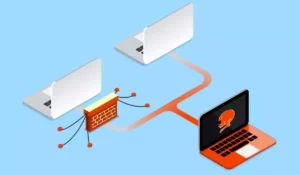Choosing a type of network is very important in any operating system because it is what ensures that you can use the interface and surf the Internet safely. Faced with this situation, many wonder if it is preferable to use a public or private network in Windows and what are the differences between each of them.
A private network is the best option if you have an internal network of computers connected to each other and you want maximum security and privacy. On the other hand, public networks are more suitable for places where people outside the internal network will be connected, such as bars, schools, and restaurants.
In any case, you probably still have doubts about which is the most practical alternative and what is the best configuration for Windows. Here, we will discuss specifically each of these networks, analyzing when each of them is recommended.
What is a network?
In order to understand the concepts of public and private networks in Windows, we have to first clarify what exactly a network is. A network is a way through which communication is established without the need for physical contact, either with a person or with a computer.
Unlike what is believed, a network does not necessarily have to have an internet connection, although it is the most common. There are internal networks in which two or more computers can communicate with each other without being connected to the internet.
On the other hand, there are also networks that require the internet to communicate, especially those in which there are computers involved that are not in the same physical space.
What is a public network?
Taking the discussed above as a basis, a public network is one that offers a communication service that is provided by a telecommunications service. In almost all cases, you have to pay to get access to that service, as happens with internet plans.
For example, every time you connect to the internet through a router, you are connecting to a public network, since many other people use that same platform. You have access to servers that, although they are in different parts of the world, together they form a single public network.
Now, it is important to clarify that the fact that a network is public does not mean that you will be able to browse the Internet without a password. It also does not mean that all your files will be visible and that other people will have access to your data.
What is a private network?
Private networks are the exact opposite of public networks, as you have the ability to become an administrator. You yourself take care of configuring, maintaining, and managing everything related to the security and permissions of that network.
For example, we can mention the networks of buildings or premises that are connected to the same switch through a cable. In situations like this, no one outside will have access to the network, much less will be able to navigate through it.
Boost Your Business
Want more clients and sales? Our web development services will optimize your website to convert more visitors into customers.
Get Started TodayThe combination of public and private networks
In most circumstances, users use a combination of public and private networks. To begin, they must be connected to an internet service, which, as we have said before, is of a public nature. Access to the large information network is requested through a plan that must be paid in advance.
However, once you set up the router at home or any other connecting device, a small private network is also created. In other words, through a public network, it is possible to configure other private networks. You will have a small section to be the administrator of one or more computers.
Of course, the same applies to smartphones and any other device that can be connected to an internet network, either via cable or via Wi-Fi.
The role of VPNs
Every day the use of virtual private networks, known by its acronym VPN, is more common. A VPN consists of a technology that allows the local area connection to be extended over a public network, but in a totally private way. As in the previous case, said connection is made through a public network but in an encrypted way.
In this sense, computers have free communication to share files without contact with the outside. A pretty clear example is when using a remote desktop. To use it, you have to connect to a public network, which in this case would be the one that offers the internet subscription service.
However, it is possible to configure that remote desktop with a virtual private network so that it does not come into contact with the public network that is providing the connection.
Characteristics of private and public networks
It is now clear what each type of network consists of, but apart from the basic concepts, it is a good idea to dig deeper or remember some of its characteristics. They are the ones that make the difference when choosing a configuration for your computer.
Public networks
- A paid subscription is required to access the vast information network.
- Virtually everyone can access these networks, as long as they have subscribed to a service.
- They are quite large, and sometimes they even spread nationally and internationally.
- Although they are public, they are subject to privacy and security regulations.
- The devices connected can restrict the use of shared files through identification.
- Although there is security, there is much more probability that there is some type of vulnerability or external attacks.
- The connection speed depends on the contracted service.
Private networks
- Only devices within the range of the network have access.
- Credentials are required to access that network.
- Permissions, devices, and access can be configured precisely.
- They are compatible with the use of VPN.
- They are connected to a public network that serves as a link.
- The transfer speed depends on the capacity of the router.
Public or private network in Windows: which is better?
Technically speaking, it is not that one network is better than the other, but that they are used in different circumstances. In fact, when you connect your computer to a network, the first thing Windows does is ask what type of network it is, public or private. This is because the system has to recognize where the connection is coming from in order to implement a different security protocol.
Depending on the type of connection, Windows will configure different settings for the firewall and file sharing permissions.
Private networks
If you select the private network option, the operating system will automatically understand that you are within an organization. Of course, this can be the one in your home, office, or even a room, as the size is defined by you as the user.
During that time, the network is isolated by a device, which would be the administrator from which it is possible to adjust the use of shared files. In this way, you can choose who has access to the information and even allow them to make changes.
Public network
If you connect to a public network, the operating system understands that you are connected to a network in which there are also other users. They do not have to know anything about you at all, so the computer will go to great lengths to increase security protocols even further.
This means that other devices will not be able to see if you are connected to that network. Of course, there are ways to find out, but they are already beyond the knowledge of the usual user, who is the one who will normally connect to a public network.
Change network settings in Windows
If you want to change the public and private network settings, or verify in which mode you are connected, everything is done from the same Windows interface.
- Go to the Settings menu and click on the Network and Internet section.
- Then, click on the Status button and then on Properties.
- Once you are in this section, you have to click on Network Profile.
- There you can change the settings between public and private as many times as you need.
Final clarifications
To conclude, it is important to note that Windows asks what type of network it is connecting to every time it recognizes a new one. That is, if you connect to your home Wi-Fi network, it asks if it is public or private. If you do it again, but through a cable, the computer asks again.
If you leave your home and connect the laptop to a new Wi-Fi network, it again prompts you for information. It is a protocol that is constantly repeated to give you the greatest security when browsing the internet.
Boost Your Business
Want more clients and sales? Our web development services will optimize your website to convert more visitors into customers.
Get Started Today







